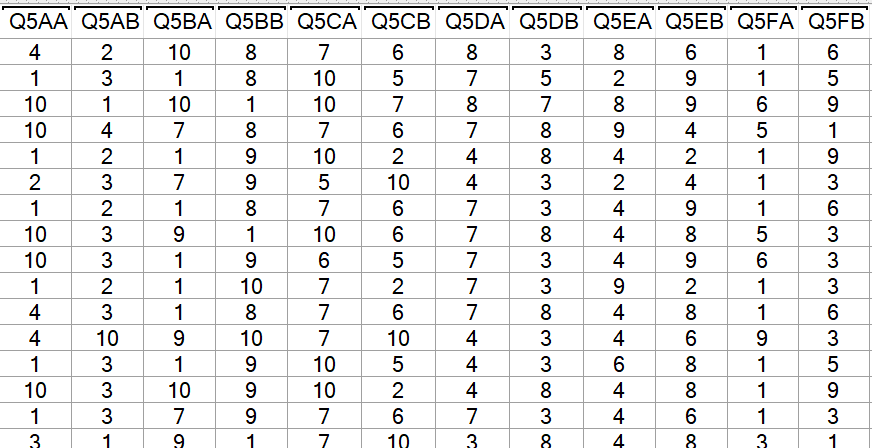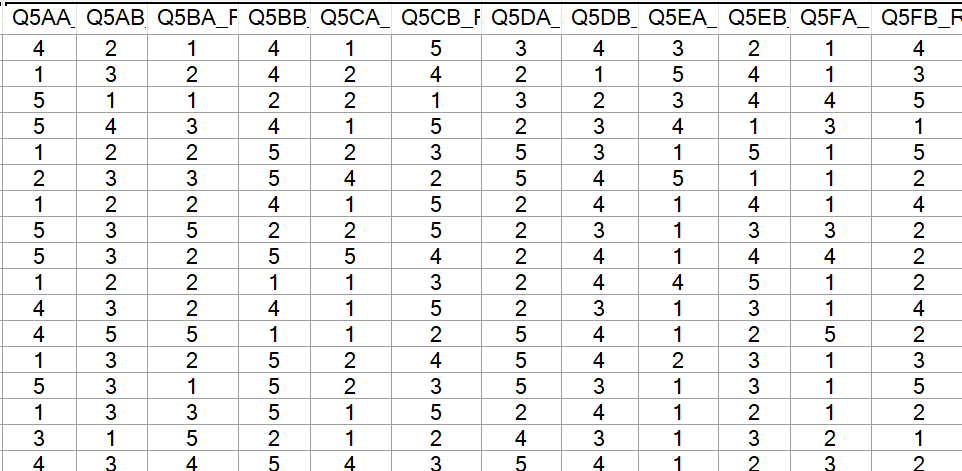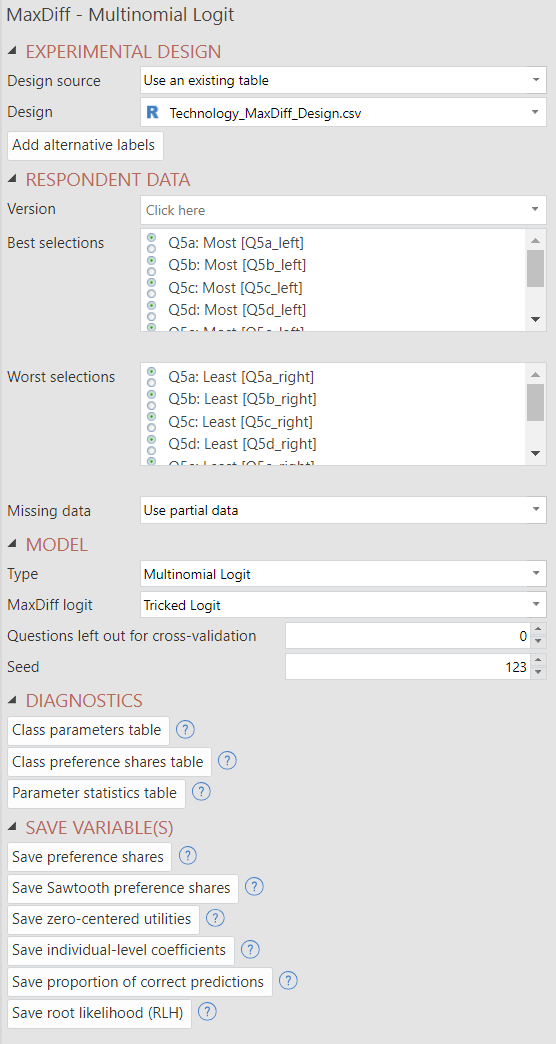Marketing - MaxDiff - Multinomial Logit
Performs multinomial logit on MaxDiff data, which is equivalent to a single-class latent class analysis.
Example
In Displayr, to run the MaxDiff - Multinomial Logit, select Insert > More > MaxDiff > Multinomial Logit.
In Q, select Create > Marketing > MaxDiff > Multinomial Logit.
The table below shows the output of multinomial logit using MaxDiff data on technology companies. The distribution of respondent parameters is displayed for each alternative, with blue and red columns corresponding to positive and negative parameters respectively:
The Design input table needs to be in a form similar to the one shown below. The 'Version' column is optional when there is only one version in the design. The 'Question' column is also optional. However, if these columns are included, they must have the names 'Version' and 'Question'. The columns after this contain the indices of the alternatives presented to the respondents.
Data Setup
The respondent MaxDiff choices can be stored as either the alternative number or the option number. The alternative number represents the number of alternatives analyzed in the experiment, for example, if there were 8 alternatives, the values 1-8 would be stored in the best/worst variables as show here:
When the option number is captured instead of the alternative number, the the number of the option selected is used instead of the alternative number. For example, if 5 alternatives were shown to respondents for each question, then the values 1-5 are stored in the best/worst variables as shown below:
Note that when the data is setup based on option number, the Question Type for the respondent MaxDiff selections should be set to Number - Multi.
Options
The inputs used to generate the Multinomial Logit are shown below.
Experimental Design
Design location One of,
- Use an existing table Select an existing table in the project in Design.
- Experimental design R output Select a MaxDiff design created with Marketing - MaxDiff - Experimental Design.
- Variables Provide Alternatives (and optionally Design version) where each alternative contains the alternatives presented by question, analogous to the columns of a tabular design.
- Provide a URL Enter a URL in Design URL.
Design The design table. This may contain a 'Version' column and if not present there is assumed to be one version. It may also contain a 'Question' column. All other columns are assumed to contain the alternatives presented, hence the number of other columns defines the number of alternatives per question.
Design URL The URL to a CSV file containing the design.
Alternative labels Labels for the alternatives specified in the first column of the data editor. This can be left out in most cases as the alternatives can usually be extracted from the best and worst selections.
Respondent Data
Version A variable which indicates which version of the design was provided to each respondent.
Best selections The best selections for each question. Can be categorical variables with labels matching the labels in the design; categorical variables containing the selected option value (e.g. "Option 1", "Option 2", "Option 3" for a design with three alternatives shown per question); numeric variables taking values from 1, 2, ..., up to the number of alternatives; or numeric variables taking values from 1, 2, ..., up to the number of options shown per question.
Worst selections The worst selections for each question. Should have the same format as Best selections.
Missing data See Missing Data Options.
Model
Type Switch between MaxDiff models: Latent Class Analysis, Hierarchical Bayes and Varying Coefficients.
MaxDiff logit Choose between Tricked Logit and Rank-Ordered Logit with Ties. The former is faster but the latter is used in Segments > Latent Class Analysis for MaxDiff in Q.
Questions left out for cross-validation The number of questions to leave out per respondent to be used for cross-validation.
Seed The random seed used to determine the random initial parameters of the model and also used to determine the random questions to leave out for cross-validation.
DIAGNOSTICS
Class Parameters Table Create a table showing parameters by class (there is only one class in the case of multinomial logit).
Class Preference Shares Table Create a table showing preference shares by class (there is only one class in the case of multinomial logit).
Parameter Statistics Table Creates a table showing the parameter statistics for the model.
SAVE VARIABLE(S)
Sawtooth-Style Preference Shares (K Alternatives) Saves variables that contain Sawtooth-style preference shares (K alternatives).
Individual-Level Coefficients Saves variables that contain the individual-level coefficients (utilities).
Preference Shares Saves variables that contain preference share for each alternative by respondent.
Proportion of Correct Predictions Save a variable that contains the proportion of correct 'best' predictions for each respondent.
RLH (Root-Likelihood) Saves a variable that contains the root likelihood for each respondent.
Zero-Centered Utilities Saves variables that contain the zero-centered utilities.
Additional Properties
When using this feature you can obtain additional information that is stored by the R code which produces the output.
- To do so, select Create > R Output.
- In the R CODE, paste: item = YourReferenceName
- Replace YourReferenceName with the reference name of your item. Find this in the Report tree or by selecting the item and then going to Properties > General > Name from the object inspector on the right.
- Below the first line of code, you can paste in snippets from below or type in str(item) to see a list of available information.
For a more in depth discussion on extracting information from objects in R, checkout our blog post here.
Properties which may be of interest are:
- The proportion of total sample assigned to each class:
- item$class.sizes # class membership sample proportions
- The overall brand preference shares by class segment"
- item$class.preference.shares # class brand preference shares
Technical Details
The parameters are scaled to sum to zero after estimation (the parameters for the first alternative are constrained to zero during estimation).
More information
See How to Analyze MaxDiff Data in Q for information on using this feature.
Code
var allow_control_groups = Q.fileFormatVersion() > 10.9; // Group controls for Displayr and later versions of Q
if (allow_control_groups)
form.group({ label: "Experimental design", expanded: true });
var dt = form.comboBox({ name: "formDesignLocation", label: "Design source", alternatives: ["Use an existing table", "Experimental design R output", "Variables", "Provide a URL"],
default_value: "Use an existing table", prompt: "Select design source" }).getValue();
if (dt == "Use an existing table")
form.dropBox({ name: "formDesign", label: "Design", types: ["Table", "RItem:matrix,array,data.frame,table"], required: true, prompt: "Select a design from a table" });
else if (dt == "Experimental design R output")
form.dropBox({ name: "formDesign", label: "Design", types: ["RItem:MaxDiffDesign,data.frame"], required: true, prompt: "Select a MaxDiff design object" });
else if (dt == "Variables") {
form.dropBox({ label: "Alternatives",
types: ["Variable: Numeric, Categorical, OrderedCategorical"],
name: "formAlternatives", required: true, multi: true,
prompt: "Select design alternative variables" });
form.dropBox({ label: allow_control_groups ? "Design version" : "Experimental design version",
types: ["Variable: Numeric, Categorical, OrderedCategorical"],
name: "formDesignVersion", required: false,
prompt: "Select the design version variable" });
}
else
form.textBox({ name: "formURL", label: "Design URL", required: true, prompt: "Specify a URL to the design file" });
if (dt != "Experimental design R output")
form.dataEntry({ name: "formLabels",
prompt: "Enter alternative labels (optional)",
required: false,
default_value: [["Enter alternative labels below:"]], label: "Add alternative labels",
edit_label: "Edit alternative labels",
large_data_error: "The data entered is too large. You may only enter data with up to 1000 rows and up to 100 columns." });
if (allow_control_groups)
form.group({ label: "Respondent data", expanded: true });
form.dropBox({ label: allow_control_groups ? "Version" : "Version variable",
types: ["Variable: Numeric, Categorical, OrderedCategorical"],
name: "formVersion", required: false, prompt: "Select the respondent version variable" });
form.dropBox({ label: "Best selections",
types: ["Variable: Numeric, Categorical, OrderedCategorical"],
name: "formBest", multi: true, prompt: "Select the best choice variables" });
form.dropBox({ label: "Worst selections",
types: ["Variable: Numeric, Categorical, OrderedCategorical"],
name: "formWorst", multi: true, prompt: "Select the worst choice variables" });
form.comboBox({ label: "Missing data", name: "formMissing",
alternatives: ["Error if missing data", "Exclude cases with missing data", "Use partial data"],
default_value: "Use partial data", prompt: "Options for handling cases with missing data" });
if (allow_control_groups)
form.group("Model");
var type = form.comboBox({ name: "formType", label: "Type",
alternatives: ["Multinomial Logit",
"Latent Class Analysis",
"Hierarchical Bayes",
"Varying Coefficients"],
default_value: "Multinomial Logit", prompt: "Select the MaxDiff analysis type" });
var is_mnl = type.getValue() == "Multinomial Logit";
var is_lc = type.getValue() == "Latent Class Analysis";
var is_hb = type.getValue() == "Hierarchical Bayes";
var is_vc = type.getValue() == "Varying Coefficients";
var web_mode = (!!Q.isOnTheWeb && Q.isOnTheWeb());
if (is_hb && Q.fileFormatVersion() < 12.31 && !web_mode)
alert("A newer version of Q (version 5.3) is required to run Hierarchical Bayes. Please contact support@q-researchsoftware.com to upgrade.");
var heading_text = "MaxDiff - ";
if (is_mnl)
heading_text = heading_text + "Multinomial Logit";
else if (is_lc)
heading_text = heading_text + "Latent Class Analysis";
else if (is_vc)
heading_text = heading_text + "Varying Coefficients";
else if (is_hb)
heading_text = heading_text + "Hierarchical Bayes";
if (!!form.setObjectInspectorTitle)
form.setObjectInspectorTitle(heading_text, heading_text);
else
form.setHeading(heading_text);
if (is_vc || is_hb)
form.dropBox({ label: "Covariates",
types: ["Variable: Numeric, Categorical, OrderedCategorical"],
name: "formCovariates", multi: true, required: is_vc, prompt: "Select covariate variables" });
if (is_vc)
var lc = form.checkBox({ label: "Additional latent class analysis", name: "formLC", default_value: true, prompt: "Run a final latent class analysis" });
if (is_lc | (is_vc && lc.getValue()))
form.numericUpDown({ name: "formClassesLC", label: "Number of classes", default_value: 2, increment: 1, maximum: 100, minimum: 1,
prompt: "Specify the number of classes in the model" });
if (is_hb) // separate controls for HB and LC so classes are not carried over
form.numericUpDown({ name: "formClassesHB", label: "Number of classes", default_value: 1, increment: 1, maximum: 100, minimum: 1,
prompt: "Specify the number of classes in the model" });
form.comboBox({ label: "MaxDiff logit", alternatives: ["Tricked Logit", "Rank-Ordered Logit with Ties"], name: "formModel",
default_value: "Tricked Logit", prompt: "Select MaxDiff logit treatment" });
form.numericUpDown({ name: "formCV", label: "Questions left out for cross-validation", default_value: 0, increment: 1,
maximum: 100, minimum: 0, prompt: "Specify number of questions to leave out" });
form.numericUpDown({ name: "formSeed", label: "Seed", default_value: 123,
prompt: "The random seed", minimum: -999999999, maximum: 999999999,
increment: 1 });
if (is_hb) {
form.numericUpDown({ name: "formIterations", label: "Iterations", default_value: 100, increment: 10,
maximum: 1000000, minimum: 1, prompt: "Specify number of hierarchical Bayes iterations" });
form.numericUpDown({ name: "formChains", label: "Chains", default_value: 8, increment: 1,
maximum: 1000, minimum: 1, prompt: "Specify number of chains" });
form.numericUpDown({ name: "formMaxTreeDepth", label: "Maximum tree depth", default_value: 10, increment: 1,
maximum: 1000, minimum: 1, prompt: "Specify maximum tree depth (only change if necessary)" });
form.numericUpDown({ name: "formAdaptDelta", label: "Adapt delta", default_value: 0.8, increment: 0.001,
maximum: 0.999, minimum: 0.001, prompt: "Specify adapt delta (only change if necessary)" });
}
if (is_lc) {
form.numericUpDown({ name: "formNStarts", label: "Number of starts", default_value: 1,
prompt: "Number of times to start LCA", minimum: 1, maximum: 1000000,
increment: 1 });
}
library(flipMaxDiff)
df <- if (formType == "Varying Coefficients" && exists("formCovariates")) {
names(formCovariates) <- sapply(formCovariates, function(x) attr(x, "label"))
formCovariates
} else
NULL
if (formType == "Hierarchical Bayes"){
frml <- QFormula(~formCovariates)
dat <- QDataFrame(formCovariates)
if (!length(dat))
frml <- dat <- NULL
}else
frml <- dat <- NULL
if (exists("formURL")) {
md.design <- try(read.csv(formURL))
if (inherits(md.design, "try-error") || NCOL(md.design) <= 1L)
StopForUserError("The provided Design URL does not contain a valid design file. ",
"The URL needs to be a downloadable link containing a file that ",
"can be read in CSV format. Please edit the link and try again.")
keep <- apply(md.design, 1, function(x) !all(is.na(x)))
md.design <- md.design[keep, ]
}
max.diff <- FitMaxDiff(design = if(exists("formDesign")) formDesign else if (exists("formURL")) md.design,
version = if (is.null(formVersion)) rep(1, length(formBest[[1]])) else formVersion,
best = if (exists("formBest")) formBest,
worst = if (exists("formWorst")) formWorst,
design.alternatives = if (exists("formAlternatives")) formAlternatives,
design.version = if (exists("formDesignVersion")) formDesignVersion,
alternative.names = if (exists("formLabels") && !any(dim(formLabels) == c(0, 0)) && !all(dim(formLabels) == c(1, 1))) formLabels else NULL,
n.classes = get0("formClassesLC", ifnotfound = 1) * get0("formClassesHB", ifnotfound = 1),
subset = if (all(QFilter)) NULL else QFilter,
weights = QPopulationWeight,
missing = formMissing,
characteristics = df,
cov.formula = frml, cov.data = dat,
lc = if (exists("formLC")) formLC else TRUE,
output = "Parameters",
tasks.left.out = formCV,
is.tricked = if(exists("formModel")) formModel == "Tricked Logit" else TRUE,
algorithm = if (formType == "Hierarchical Bayes") "HB-Stan" else "Default",
hb.iterations = if(exists("formIterations")) formIterations else 0,
hb.chains = if(exists("formChains")) formChains else 0,
hb.max.tree.depth = if(exists("formMaxTreeDepth")) formMaxTreeDepth else 0,
hb.sigma.prior.rate = 1,
hb.sigma.prior.shape = 1,
hb.adapt.delta = if(exists("formAdaptDelta")) formAdaptDelta else 0,
seed = formSeed,
lc.n.starts = if (exists("formNStarts")) formNStarts else 1)
See Also
Other MaxDiff models:
- Marketing - MaxDiff - Latent Class Analysis
- Marketing - MaxDiff - Hierarchical Bayes
- Marketing - MaxDiff - Varying Coefficients
Compare MaxDiff models:
Create an ensemble of MaxDiff models:
Diagnostics for MaxDiff latent class analysis outputs:
- Marketing - MaxDiff - Diagnostic - Class Parameters
- Marketing - MaxDiff - Diagnostic - Class Preference Shares
Save variables from MaxDiff latent class analysis outputs:
- Marketing - MaxDiff - Save Variable(s) - Class Membership Probabilities
- Marketing - MaxDiff - Save Variable(s) - Compute Preference Shares
- Marketing - MaxDiff - Save Variable(s) - Compute Sawtooth-Style Preference Shares (K Alternatives)
- Marketing - MaxDiff - Save Variable(s) - Compute Zero-Centered Utilities
- Marketing - MaxDiff - Save Variable(s) - Individual-level Coefficients
- Marketing - MaxDiff - Save Variable(s) - Membership
- Marketing - MaxDiff - Save Variable(s) - Proportion of Correct Predictions
See MaxDiff Software or What is MaxDiff? for an overview of key MaxDiff concepts and resources, and also Latent Class Analysis Software.


